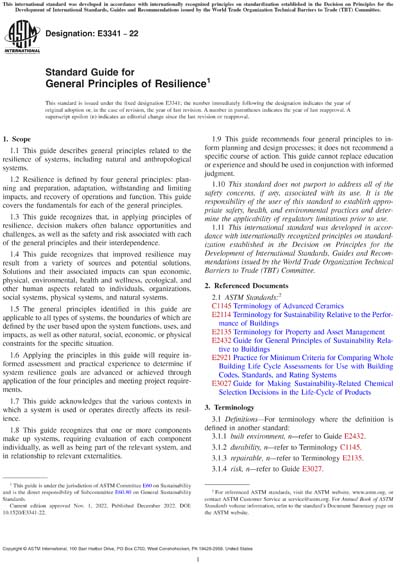Historical
ASTM E3341-22
Standard Guide for General Principles of Resilience
1.1This guide describes general principles related to the resilience of systems, including natural and anthropological systems.
1.2Resilience is defined by four general principles: planning and preparation, adaptation, withstanding and limiting impacts, and recovery of operations and function. This guide covers the fundamentals for each of the general principles.
1.3This guide recognizes that, in applying principles of resilience, decision makers often balance opportunities and challenges, as well as the safety and risk associated with each of the general principles and their interdependence.
1.4This guide recognizes that improved resilience may result from a variety of sources and potential solutions. Solutions and their associated impacts can span economic, physical, environmental, health and wellness, ecological, and other human aspects related to individuals, organizations, social systems, physical systems, and natural systems.
1.5The general principles identified in this guide are applicable to all types of systems, the boundaries of which are defined by the user based upon the system functions, uses, and impacts, as well as other natural, social, economic, or physical constraints for the specific situation.
1.6Applying the principles in this guide will require informed assessment and practical experience to determine if system resilience goals are advanced or achieved through application of the four principles and meeting project requirements.
1.7This guide acknowledges that the various contexts in which a system is used or operates directly affects its resilience.
1.8This guide recognizes that one or more components make up systems, requiring evaluation of each component individually, as well as being part of the relevant system, and in relationship to relevant externalities.
1.9This guide recommends four general principles to inform planning and design processes; it does not recommend a specific course of action. This guide cannot replace education or experience and should be used in conjunction with informed judgment.
1.10This standard does not purport to address all of the safety concerns, if any, associated with its use. It is the responsibility of the user of this standard to establish appropriate safety, health, and environmental practices and determine the applicability of regulatory limitations prior to use.
1.11This international standard was developed in accordance with internationally recognized principles on standardization established in the Decision on Principles for the Development of International Standards, Guides and Recommendations issued by the World Trade Organization Technical Barriers to Trade (TBT) Committee.
Content Provider
ASTM International [astm]






